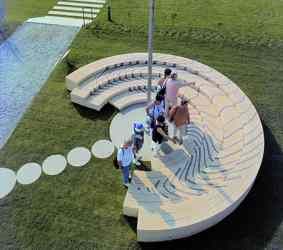Sundial spider
A sundial spider is a sundial with a shadow-casting rod fixed vertically on the dial. Odd hour lines emanate from the base of the staff, reminiscent of the legs of a spider sitting at this point.

The horizontal dial and vertical shadow object is an azimuthal sundial . The shadow direction is the opposite of the solar azimuth , for example a northerly direction if the sun has a southerly direction. The time of day is a function of the solar azimuth and elevation . The latter is also recorded by reading just one point of the rod shadow. The declination angle of the sun is used as a parameter : the dial is usually provided with concentric circles encoded with the declination or the corresponding date in the year. The time of day is read off where the rod shadow intersects the currently valid date circle. In general, interpolation is two-dimensional, both between two adjacent hour lines and between two adjacent date circles. The geographical latitude is incorporated into the dial as a device constant .
To display the true local time (WOZ), the date circles can be used for two annual dates each, because the declination of the sun has the same value twice a year. Such a sundial spider was probably made by Gerbert von Aurillac - who later became Pope Silvester II .
Sundial spiders are also suitable for mean local time (MONT) or zone time (e.g. CET) with little effort . The number of date circles is twice as high, because the time compensation only has the same value again after a whole year. The hour lines - like an equation of time diagram line - are particularly clearly reminiscent of spider legs due to their multiple wiggling back and forth (picture left).
Sundial spiders are also available with a vertical dial and a horizontal shadow bar. They are improved canonical sundials (right picture).
literature
- Arnold Zenkert: The fascination of the sundial. 4th, revised and expanded edition. Harri Deutsch, Frankfurt am Main et al. 2002, ISBN 3-8171-1665-9 .
Web links
- Horizontal sundial spider in Plochingen
- Vertical sundial spider for mean local time, picture from a brochure
Individual evidence
- ↑ René RJ Rohr: The sundial. History, theory, function. Callwey, Munich 1982, ISBN 3-7667-0610-1 , pp. 148 and 149, fig. 239.
- ^ Reconstruction by Armin Zinner: The sundial of Gerbert von Aurillac. A 10th century azimuthal sundial. In: German Society for Chronometry. Annual journal. Vol. 38, 1999, ISSN 1617-0113 , pp. 150-158.
- ↑ René RJ Rohr: The sundial. History, theory, function. Callwey, Munich 1982, ISBN 3-7667-0610-1 , p. 149, fig. 238.
